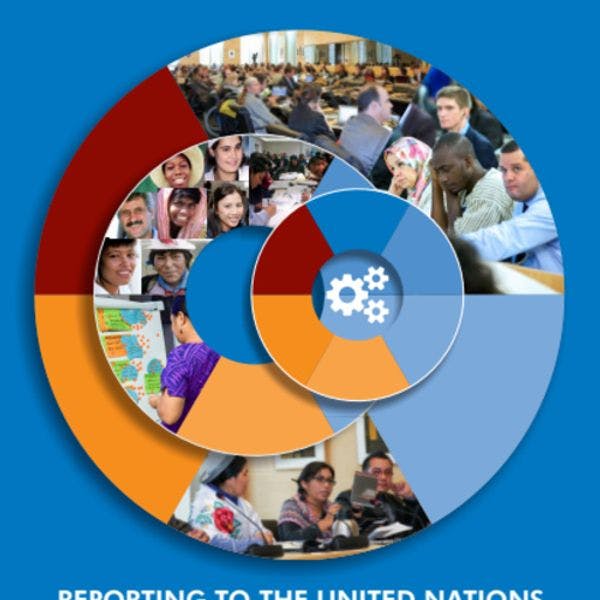Reporting to the United Nations Human Rights Treaty bodies - Training guide
This publication constitutes the second part of the Training Guide on Reporting to the United Nations Human Rights Treaty Bodies (henceforth the Training Guide). Part II aims at assisting training facilitators in preparing a training course on reporting to the United Nations human rights Treaty Bodies (henceforth treaty reporting).
1. HOW DOES PART II COMPLEMENT PART I OF THE TRAINING GUIDE? Part I provides facilitators with the main information to be transmitted to participants of a training course on treaty reporting, and Part II equips them with the tools to plan and deliver such a course, based on the substantive information provided in Part I. For ease of reference, the chapter titles and sections of Part I (Manual) correspond directly to the chapter titles and sections of Part II (Notes for Facilitators).
2. WHO WILL UNDERTAKE THE TRAINING AND FOR HOW MANY PERSONS? It is expected that a lead facilitator familiar with human rights standards, terminology and human rights mechanisms will undertake a training course on treaty reporting. This facilitator would ideally have assistance. Preferably a training course should be designed for relatively small groups of a maximum of 25 participants to ensure an active role for everyone throughout the course.
3. WHO IS THE TARGET AUDIENCE OF A TREATY REPORTING TRAINING? As stated in Part I of this Training Guide, the main beneficiaries of a training course on treaty reporting are, in principle, government officials responsible for engaging with the international human rights mechanisms. However, individuals or representatives of organizations or institutions who also have a role to play in the treaty reporting procedure, such as UN staff, national human rights institutions (NHRIs) or civil society organizations (CSOs), may also benefit from such a course. Some suggestions will be provided, where relevant, on how to adapt a training session to these audiences.
4. WHAT IS THE TRAINING METHODOLOGY USED? The Training Guide is based on OHCHR’s training methodology, which encourages participants to play an active role during a training course. Facilitators should ensure that the training sessions turn into discussions and an exchange of information and experience with and between the participants and not into a one-way monologue in which the facilitator imparts information and the participants take note. Moreover, facilitators should encourage participants to contribute their professional expertise to the joint analysis of how to engage sustainably and meaningfully with the international human rights system, in particular with the Treaty Bodies. It is important that facilitators respect this peer learning approach throughout training sessions.
5. HOW IS PART II STRUCTURED? Part II contains two preliminary sections aimed at helping facilitators plan a training course on treaty reporting and organize its opening and introductory sessions. It then proposes interactive training sessions comprise a mix of computer slide presentations and group activities, following the structure of Part I of this Training Guide.All the proposed training sessions are based on the following two documents which, unless otherwise stated, are electronically available on the website of OHCHR (www.ohchr.org) under the Publications and Resources webpage.
a) A note for the facilitator which explains the session preparations and sequence; the training material required, including the answers to exercises, if needed; suggestions for background reading; and tips for the presentation of the computer slides.
b) A sample computer slide presentation which provides a series of slides to help the facilitator present the various concepts in the relevant chapter of Part I (available only on website).
Some of the training sessions also include group activity hand-outs and, where relevant, samples of materials (available only on the website) to be prepared for the group activity and, in particular, details of room arrangements. The sessions can follow two different sequences:
a) a group activity, followed by a computer slide presentation seeking to fill in any knowledge gaps; or
b) a computer slide presentation incorporating questions and answers, followed by a group activity.
6. HOW TO USE THE TRAINING GUIDE TO PLAN A TRAINING COURSE. It is assumed that if the Training Guide is used in its entirety, facilitators should be able to plan a training course composed of several training sessions, covering the generic elements of the reporting process that apply across all treaties (see Annex 1 for a sample training agenda).
Training courses do not need to cover all chapters of Part I and they need to be flexible in length. Trainers can pick and choose the design of their particular course over a half-day (e.g., on a specific element of the reporting procedure, see Annex 4 for an example), or a full day (e.g., drafting parts of a report in greater detail), or more than three days (e.g., a training course on reporting under a particular treaty, provided that the trainers are familiar with the content of the treaty; see Annex 5 and the suggestion included in Session 4.2.2). The chapters of Part I need neither be presented in a particular order nor cover all aspects of each chapter.
The proposed group activities should in no way limit the facilitator’s freedom to adapt them or introduce other useful and thought-provoking questions and exercises, provided that they are aimed at meeting the learning objectives of the training course and the corresponding training sessions. The important issue facilitators must bear in mind is that a training course should meet the needs of each specific audience to ensure its relevance, and that the training content and methodology should be tailored to the needs and experience of the target audience it is addressing.
